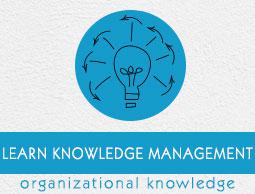Knowledge Management In organizations
Organizational Culture
Organizational culture figures out values and beliefs which are an integral part of what one chooses to see and absorb. It comprises of a shared perception of reality, regarding how things are and how things should be. Furthermore, community and group culture determines the willingness and conditions for knowledge sharing with other members of the enterprise.
Thus, knowledge and knowledge sharing, are inseparable from organizational culture. The interface for culture is social interaction, the web of communications that constitute a community.
Organizational culture can also be described in terms of both its causes and effects. Using results perspective, culture can be defined as a manifested pattern of behavior, consistent behavioral patterns observed across a group of individuals, or “the way we do things around here.” So, culture defines consistent ways in which people perform tasks, solve problems, resolve conflicts, treat customers and employees, and so on.
Using a process perspective, culture is defined as a set of mechanisms such as informal values, norms, and beliefs that control how individuals and groups in an organization communicate with each other and people outside the organization.
Different Types of Culture
This classification scheme crops four types of organizational cultures −
Communal − It give its members a sense of belongingness, though it also is task-driven. Leaders of this culture are basically very inspirational and charismatic. The drawback is that they often exert too much influence and other members are rarely vocal.
Networked − Here, the members are treated as friends and family. People closely connect with each other and love each other. They are willing to help each other and share information. The drawback of this culture is that people are so kind to each other that they are reluctant to point out and criticize the poor performance.
Mercenary − It focuses on strict goals. Here members are expected to meet the goals and to get the job done quickly. Since everyone aims on goals and objectivity, there is little room for political cliques. The drawback is that those with poor performance may be treated inhumanely.
Fragmented − Here the sense of belongingness and identification with the organization is usually very weak. The individualists comprise the organizations, and their commitment is first towards individual members and task work. The drawback is that there is a lack of cooperation.
Organizational Culture Analysis
Basically organizational culture can be split into three levels namely −
Artifacts − These impersonate the visible elements such as processes, structures, goals, climate, dress codes, furniture, etc. A foreigner can see them but may not understand why things are the way they are.
Espoused Values − The values are advocated by the leaders. They are mostly grounded in shared assumptions of how the company should be run. If there is a convincing mismatch between the leadership espoused values and this perception, the company may be in trouble.
Assumptions − These are the authentic values of the culture. They basically refer the tacit views of the world itself (like human nature). Again, these inferences should need to correlate at least to a certain degree to the espoused leadership values for the organization to function smoothly.
Effects of Culture on Individuals
There are three basic ways in which a culture effects an individual namely −
Social Norms − It is simply a behavioral expectation that people will act in a certain way in certain situations.
Shared Values − Shared values are the conscious, affective desires or wants of people who guide their behavior. For example, individuals who internalize the value of honesty feel guilty when they are cheating or faking.
Shared Mental Model − It defines a causal relationship between two durables. The idea that people depend on mental models can be traced back to reality that it uses to anticipate events. Mental models are built from perception, imagination, or the comprehension of discourse.


